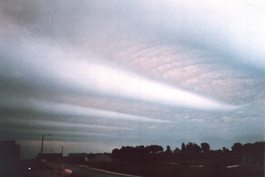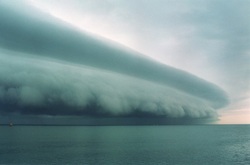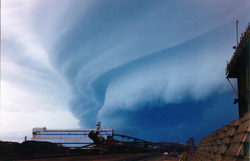How Are Meteotsunamis Created?
In general, there are three main mechanisms required for the creation of a meteotsunami:
1. A meteorologic disturbance
2. Resonance between the speed of the meteorological disturbance and deep-water wave speed
3. Amplifying qualities of a harbor, bay or inlet
1. A meteorologic disturbance
2. Resonance between the speed of the meteorological disturbance and deep-water wave speed
3. Amplifying qualities of a harbor, bay or inlet
1. Meteorologic Disturbances
There are a few different types of meteorological disturbances associated with generating meteotsunamis:
Atmospheric Gravity Waves
Atmospheric gravity waves occur when air parcels are lifted by bouyancy and pulled back down by gravity in oscillatory fashion. They are caused by wind passing over terrestrial land forms, velocity shear of the polar jet stream and radiation from space (3). See a video of a gravity wave at (4). These energy and pressure fluctuations translate to water surface and generate meteotsunamis. These gravity waves have periods of 10 to 50 minutes and particularly affect bays and inlets (7).
Frontal Passages and Pressure Jumps
Meteotsunamis are created when there is a sharp atmospheric jump of 2-10 mBar in about 3 minutes due to pressure fronts and cold fronts (5). These pressure jumps usually result in thunderstorms and tornadoes, but when passing over seas they can cause sharp differences in water level.
2. Resonance
In order for waves created by pressure differentials to build up, there must be resonance between the meteorologic disturbance and deep-water wave speed. This means that the meteorologic disturbance or front must be traveling at about the same speed as the deep-water wave speed offshore (8). In formulaic form:
U = C = (gd)^0.5
U = speed of disturbance
C = deep-water wave speed
g = gravity constant
d = depth of water
The waves are then amplified for as long as the disturbance and wave speed are in resonance, and are governed by the following equation (2):
Amplification = xf/(2*L)
xf = distance over which resonance occurs
L = length required for pressure change
U = C = (gd)^0.5
U = speed of disturbance
C = deep-water wave speed
g = gravity constant
d = depth of water
The waves are then amplified for as long as the disturbance and wave speed are in resonance, and are governed by the following equation (2):
Amplification = xf/(2*L)
xf = distance over which resonance occurs
L = length required for pressure change
3. Harbor Amplification
There are a few characteristics of harbors and bays that will lead to amplification of meteotsunami waves. “Bottle-like” bays exhibit a quick change in bottom elevation. In “V-shaped” harbors, waves are funneled in towards shore and energy density increases. When the “Q – Factor” >> 1, waves are amplified. The Q-factor is defined as follows:
Q ~ L/l
L = harbor length
l = harbor width
Most importantly, the bay, inlet or harbor must be open towards the disturbance.
Q ~ L/l
L = harbor length
l = harbor width
Most importantly, the bay, inlet or harbor must be open towards the disturbance.



